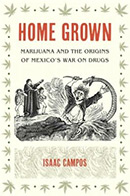Home Grown: Marijuana and the Origins of Mexico’s War on Drugs

Author: Isaac Campos
Chapel Hill, NC: University of North Carolina Press, 2012. 331p.
Reviewer: David A. Marvelli | November 2012
Isaac Campos’ Home Grown provides an insightful and much needed historical analysis on the origins of marijuana prohibition in Mexico and the United States, a prohibition that has contributed to the emergence of drug trafficking organizations. While other scholars have suggested the United States exported its counter-narcotic policies to a passive Mexico, Campos illustrates how Mexico played a much more active and critical role in forming the views and opinions of marijuana in the United States. These views and opinions, which linked marijuana use to madness and violence, were developed in Mexico long before the United States banned marijuana in 1937.
According to Campos, marijuana production in Mexico can be traced to Spain’s colonization of Mexico in the sixteenth century when Spain authorized and encouraged its production to manufacture hemp for the masts of its imperial fleet. Yet despite the fact the plant was foreign to Mexico, marijuana eventually came to be viewed as a native plant used primarily by herbolarias—or indigenous medical practitioners—soldiers, and prisoners. The nexus between marijuana and these “lower classes” became part of the nineteenth century narrative that marijuana was a substance that contributed to “degeneration,” which would stunt national progress. As a result, Mexican elites, who were concerned about national progress at a time when Europe and America were industrializing, came to view marijuana use as a national security threat.
At the same time, Campos demonstrates how Mexican news reports sensationalized the role marijuana played in violent crimes. A typical news account suggested that after smoking marijuana, an otherwise rational individual became furious and mad with “eyes-bulging” before committing his violent act. These sensationalized accounts, however, gained some level of endorsement at the time by the medical profession, which suggested marijuana caused temporary insanity with permanent effects of “madness” for frequent users over a prolonged period of time. These forces combined with the concerns for degeneration ensured the absence of a counter-discourse on the effects of marijuana and the passage of Mexico’s national prohibition of marijuana in 1920.
Yet beginning in the 1890s, the view that marijuana caused crime, violence and madness began to be exchanged with Americans. Campos demonstrates how Americans—unfamiliar with the Mexican-named drug—actively sought out the advice of those who encountered the narcotic and its users. This exchange of “expertise,” which was commonly cited in newspapers and medical texts, would form the foundation for the United States anti-marijuana sentiment, leading to marijuana’s prohibition in the United States.
While Campos suggests the current violence in Mexico is a direct result of anti-drug policies, he avoids offering policy prescriptions. Instead he cites current public opinion polls, which suggest there is still a strong anti-marijuana sentiment in Mexico compared to the United States where an increasing number of individuals support legalizing the drug.
Home Grown is a must read for historians, criminologists, analysts, and policy-makers, alike, especially those interested in understanding the origins of Mexico’s current political and social unrest, the cultural underpinnings for marijuana prohibition, or the broader “War on Drugs.”
David A. Marvelli is a Ph.D. candidate at Rutgers University and an intelligence analyst for the Federal Bureau of Investigation
The views and opinions expressed herein are those of the author and do not necessarily reflect the views of the Federal Bureau of Investigation.


